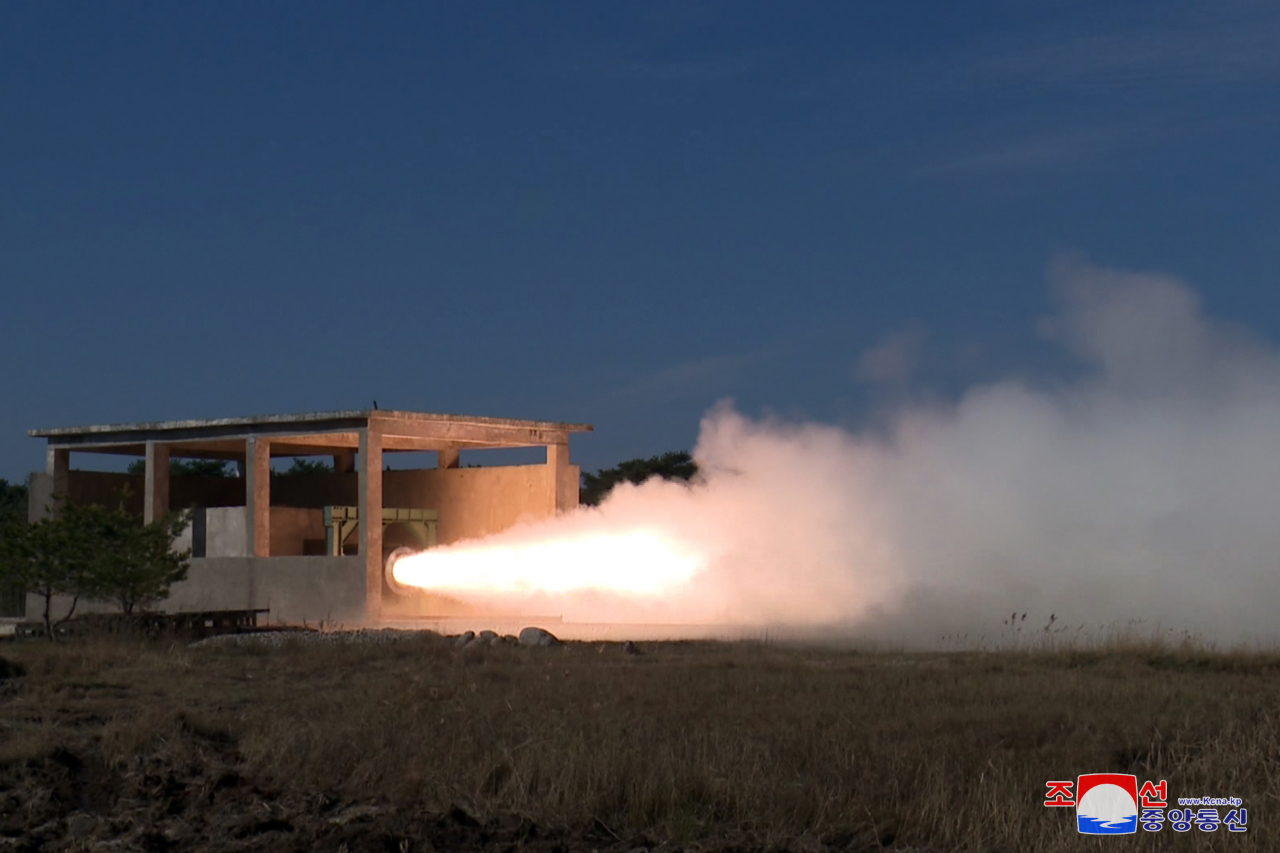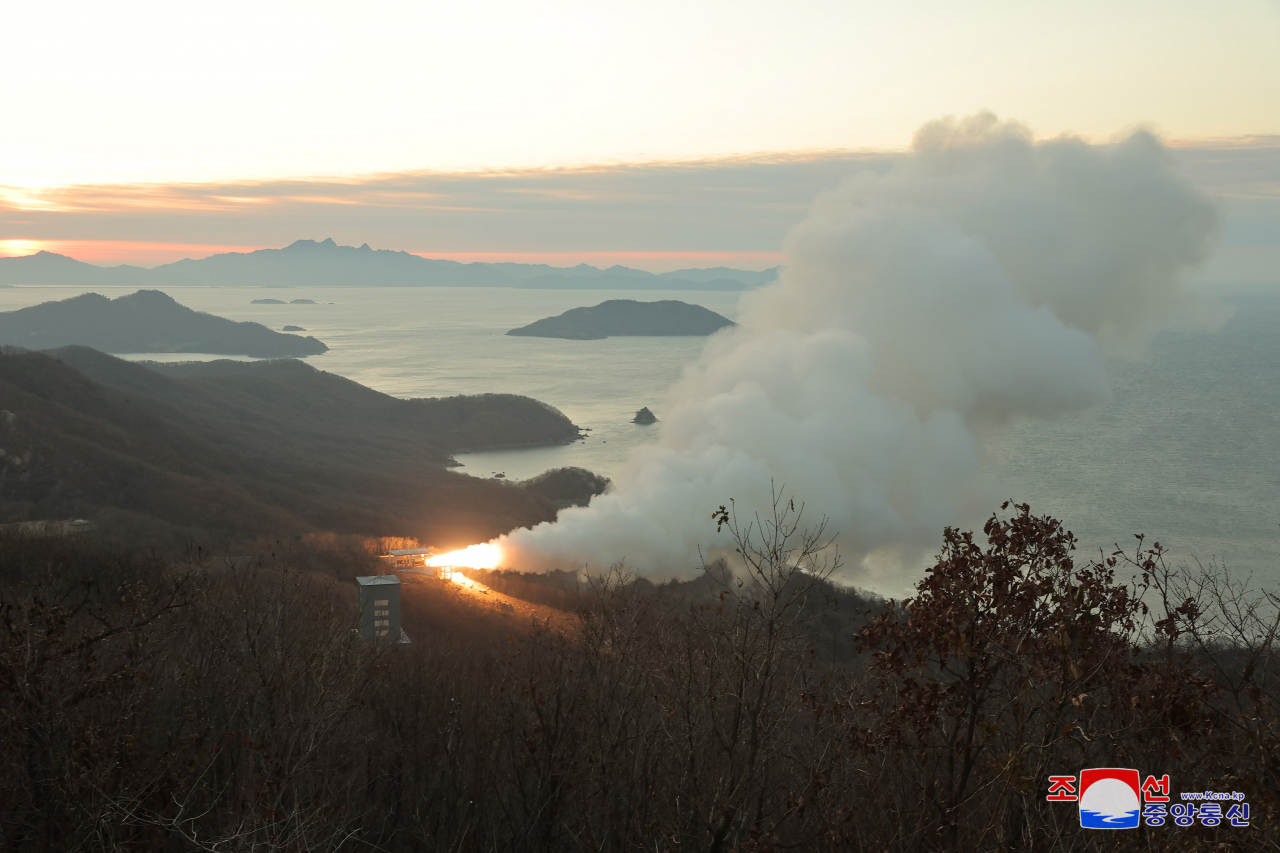N. Korea 'satisfied' with tests of solid-fuel engines for IRBM
North Korea's IRBM development targets US bases in non-contiguous territories, say experts
By Ji Da-gyumPublished : Nov. 15, 2023 - 15:19

North Korea conducted the first ground tests of solid-fuel engines for a new type of intermediate-range ballistic missile last week and this week in the run-up to the country's newly-designated Missile Industry Day, the state-run Korean Central News Agency reported Wednesday.
The country's state media reported "highly satisfactory results" from the inaugural ground jet tests conducted on Nov. 11 for the first-stage engine and on Tuesday for the second-stage engine.
The two ground tests instilled further confidence in expediting the reliable development of a new IRBM, which was designated as one of the key tasks in the missile industry in North Korea's "2023 Plan for Developing Defense Science and Weapons Systems."
Experts perceive this news as part of Pyongyang's ongoing efforts to diversify solid-fuel missiles with greater mobility and survivability, including one that can hit US bases in non-contiguous territories such as Guam.
Shin Jong-woo, a senior analyst at the Korea Defense and Security Forum, noted that a new solid-fuel IRBM with a second-stage propulsion system would have an increased range compared to existing liquid-fuel IRBMs, such as the single-stage Hwasong-12, which has a range of around 3,000 kilometers.
"North Korea's pursuit to develop a solid-fuel intermediate-range ballistic missile can be interpreted as its intention to acquire capabilities to make surprise strikes on US bases in Guam, Alaska, as well as Japan," Shin told The Korea Herald.
The straight-line distance from Pyongyang to Guam is approximately 3,500 kilometers, and to Alaska, it is about 6,000 kilometers. Guam is home to strategic assets of the US military, including B-52 strategic bombers, while ground-based systems for intercepting ICBMs are stationed in Alaska.
Chang Young-keun, the director of the Missile Center at the Korea Research Institute for National Strategy, also highlighted the rationale behind North Korea's decision to conduct tests of a solid-fuel engine for a new IRBM, despite having launched the solid-fuel intercontinental ballistic missile, the Hwasong-18, in April and July this year.
North Korea has developed solid-fueled ballistic missiles such as the KN-23, KN-24, and KN-25 short-range ballistic missiles, the Pukguksong-2 medium-range ballistic missile with an approximate range of 2,000 km, and the Hwasong-18 ICBM, which underwent two lofted angle tests this year.
Notably absent from their current missile inventory is a solid-fuel IRBM with a range falling between 3,000 and 5,500 km. The existing IRBMs in North Korea's possession, including the Hwasong-12, are all liquid-fuel missiles.
Solid-fuel missiles have advantages over liquid-fueled missiles in that they can be fueled during their manufacturing process. They can also be launched on short notice.
"Therefore, it appears that North Korea is striving to develop and deploy a novel solid-fuel intermediate-range ballistic missile, prompted by the imperative need for a 3,000-km-range missile capable of targeting US military bases in Guam," Chang said. "The move shows the country's intention to diversify offensive capabilities, aiming for a strategic advantage."

According to Cheong Seong-chang, the director of the Department of Reunification Strategic Studies at the Sejong Institute, the state media report suggests the possibility of North Korea test-launching a new IRBM with the attendance of North Korean leader Kim Jong-un and his daughter, Kim Ju-ae.
Cheong said the launch could take place before the newly established "Missile Industry Day," which falls on Nov. 18.
The day was designated at a meeting of the Presidium of the Supreme People's Assembly to commemorate the first test launch of intercontinental ballistic missile Hwasong-17 on Nov. 18, 2022, state media reported earlier this month. Ju-ae made her first public appearance on that day.
"If the test launch of the intermediate-range ballistic missile proves successful, North Korea has the potential to celebrate Missile Industry Day and the first anniversary of Kim Ju-ae's official appearance in a jubilant atmosphere," Cheong said.
"Nevertheless, if logistical challenges hinder the test before Nov. 18, there is an expectation that North Korea will proceed with a test launch of an intermediate-range ballistic missile before the year's end, positioning it as a significant achievement in the defense sector for this year," he continued.
In the face of North Korea's ongoing missile development, Washington has maintained its commitment to extended deterrence by enhancing the regular visibility of strategic assets to the Korean Peninsula.
The US Navy's nuclear-powered aircraft carrier, USS Carl Vinson, is scheduled to enter the South Korean naval base in Busan next week, The Korea Herald learned from military sources.
The US Air Force's nuclear-capable B-52 strategic bombers flew to the Korean Peninsula for a combined air exercise with its South Korean ally on Wednesday, less than one month after a weeklong landing of B-52 strategic bombers at the South Korean airbase in mid-October.
Wednesday marks the 12th combined air exercise conducted this year, in conjunction with the deployment of US strategic bombers to the peninsula, South Korea's Defense Ministry said Wednesday.
The latest exercise unfolded in the airspace over the Yellow Sea and included the participation of South Korean Air Force's F-35A and F-15K fighter jets, alongside F-35B and F-16 fighter aircraft from the US Air Force.
South Korea's Defense Ministry emphasized that the combined air exercise, featuring US strategic bombers, "demonstrated the alliance's combined operational capabilities, enabling an immediate, overwhelming and decisive response to any provocations from North Korea."



















![[Today’s K-pop] Treasure to publish magazine for debut anniversary](http://res.heraldm.com/phpwas/restmb_idxmake.php?idx=642&simg=/content/image/2024/07/26/20240726050551_0.jpg&u=)